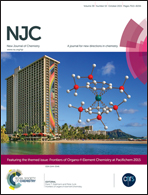A novel water-soluble hydrophobically associating polyacrylamide based on oleic imidazoline and sulfonate for enhanced oil recovery†
Abstract
3-(2-(2-Heptadec-8-enyl-4,5-dihydro-imidazol-1-yl)ethylcarbamoyl)acrylic acid (NIMA), 3-(diallyl-amino)-2-hydroxypropyl sulfonate (NDS), acrylamide (AM) and acrylic acid (AA) were successfully utilized to prepare novel acrylamide-based copolymers (named AM/AA/NIMA and AM/AA/NDS/NIMA) which were functionalized by a combination of imidazoline derivative and/or sulfonate via redox free-radical polymerization. The two copolymers were characterized by infrared (IR) spectroscopy, 1H nuclear magnetic resonance (1H NMR), viscosimetry, pyrene fluorescence probe, thermogravimetry (TG) and differential thermogravimetry (DTG). As expected, the polymers exhibited excellent thickening property, shear stability (viscosity retention rate 5.02% and 7.65% at 1000 s−1) and salt-tolerance (10 000 mg L−1 NaCl: viscosity retention rate up to 17.1% and 10.2%) in comparison with similar concentration partially hydrolyzed polyacrylamide (HPAM). The temperature resistance of the AM/AA/NDS/NIMA solution was also remarkably improved and the viscosity retention rate reached 54.8% under 110 °C. According to the core flooding tests, oil recovery could be enhanced by up to 15.46% by 2000 mg L−1 of the AM/AA/NDS/NIMA brine solution at 80 °C.


 Please wait while we load your content...
Please wait while we load your content...